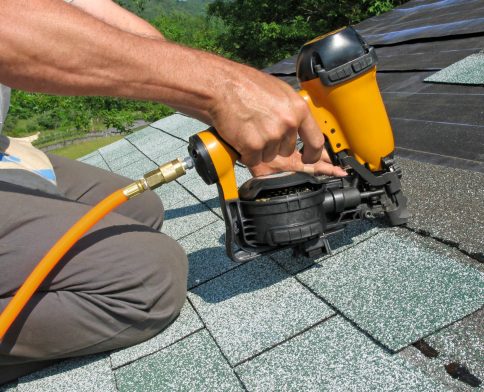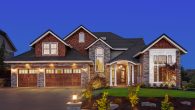How Much Do Roofing Shingles Cost?
September 21, 2022

Shingles are commonly used on both residential and commercial properties. Whether you’re constructing a new building, considering a roofing upgrade, or wondering about the effect of a few missing shingles, it’s helpful to know what to expect regarding the cost of shingles.
The cost can vary dramatically depending on your roof’s shape and the type of shingles you select. However, $160 per 100 square feet—or $1.60 per square foot—is considered average for standard roofing in most locations. The unit of 100 square feet is referred to as a “square,” and the square buys most shingles.
An average asphalt shingle is three square feet, measuring one foot by three feet. They come in various styles, all made up of the same primary materials. Factors that affect the cost of shingles include the quality and durability of the materials used and the overall style.
Which Roofing Shingles Should I Buy?
Other than the cost of roofing shingles, the most common question is: what type of roofing shingle is best? Each shingle type provides a unique blend of style, protection, and cost blend.
The best way to determine which shingle is best for you is by clearly identifying your needs and your budget. There are three main types of shingles suitable for most roofing projects, listed from most affordable to most expensive:
Three-Tab Shingles
Three-tab shingles are among the most basic shingles available. The bottom of each shingle has two cuts in it, creating three even brick-shaped tabs for a consistent appearance across a roof. If you’re looking for a fast and affordable roofing solution, a three-tab shingle is the best option for you.
These shingles are also easier to install than others—while still providing high durability and low maintenance requirements. Three-tab shingles come in various color and style options to complement different architectural styles.
- Average price: $100 per square (100 square feet)
Dimensional Shingles
Also known as architectural shingles, dimensional shingles add more visual interest to a roof than three-tab shingles. Each shingle has two layers of shingle material bonded together, and random notches from the top layer expose the lower layer. This process creates a textured, random pattern that showcases a three-dimensional appearance with high and low tabs.
In addition to improved aesthetics, dimensional shingles provide more protection from wind and hail due to their double layers—for an added cost. This additional layer of material also helps extend the lifespan of the shingles up to 40 years (compared to the 20-year estimated lifespan of single-layered shingles).
Because the manufacturing process uses additional materials, dimensional shingles cost more to fabricate than basic three-tab shingles. However, the extended lifespan and added protection afforded by dimensional shingles often make the higher cost worthwhile to property owners.
- Average Price: $450 per square (100 square feet)
Luxury Shingles
The shingles that provide the most protection and the best style are luxury shingles, but those benefits come at an even higher price point. Also known as premium shingles, luxury shingles are the top of the line.
These shingles feature a layered design, which creates a wide range of unique stylistic options to help a roof stand out. Not only do luxury shingles create a one-of-a-kind look for your home, they also offer the most durability and protection.
With these appealing qualities, luxury shingles are the most expensive asphalt shingle option available on the market.
- Average Price: $950 per square (100 square feet)
How Does Size Affect the Cost of Your Roof?
It goes without saying, but the larger the roof, the more shingles are needed to cover it. A larger roof is therefore more expensive to shingle, but there’s a second reason as well: the total cost of a shingle roof is determined not only by size, but also by the pitch and design of your particular roof.
A steeply sloped roof has more square footage than a shallow sloped roof. Lower-pitched roofs are easier to install shingles on and require fewer shingles to cover, while higher-sloped roofs take more shingles to cover. Additionally, high-pitch roofs may require specialized shingles and roofers who take precautions and have additional training in the proper installation methods.
The shape and style of the roof also play a major role in the cost. A simple square or rectangle roof with a single central ridge costs less than a roof with complex features, like multiple vent pipes, chimneys, valleys, gables, hips, ridges, dormers, and skylights. Even if the square footage is the same, a home with a more complex design will cost more to shingle.
Because of these complex factors, most roofing companies and roofers will visit your home to inspect the roof. This inspection will allow them to accurately estimate for the price of installing shingles based on your roof’s size, slope, shape, and style.
Pricing is specific to each individual roof.
What About Roofs That Don’t Use Shingles?
When looking into the best roofing options, don’t forget that asphalt shingles aren’t the only material available to you. Below are two other types of roofs you can consider, and some basic information about each one. All prices listed are considered national averages per square (100 square feet) or per roof (single family home):
Metal Roofing
There are a wide variety of options in metal roofing. A metal roof is usually more expensive than a shingle roof, but metal offers more durability and has a longer estimated lifespan. Steel and aluminum roofing are the most common options, but you can also consider copper, corrugated metal, metal slates, or zinc.
When considering the cost of metal roof vs. shingles, it’s helpful to note that shingles will be cheaper but have to be replaced more often. The average lifespan of asphalt shingles is around 20 years, where a metal roof can last as long as 70 years (depending on the materials used).
- Average Price: $280–$960 per square (100 square feet)
Ceramic Tile Roofing
Tile roofs provide a unique style and elegance to any structure. Tiles tend to perform better in colder climates because the tile density can withstand freezing temperatures. A tile roof can also support wet, dense snow without sustaining damage. Ceramic tile roofs have a lifespan of about 50 years, although some roofs with clay tiles have lasted for 100 years.
The biggest consideration for ceramic tiles is the extra weight, as they weigh more than other materials. Not all homes are designed to hold the weight of tiles, and forcing tile roofing onto a home can easily damage the structure.
- Average Price: $300–$1,250 per square (100 square feet)
Other Costs to Consider
Replacing or installing a new roof involves more than just the cost of the materials used. Here are additional costs to keep in mind when considering a roofing installation project:
- Labor: Just because roofing can be a DIY project doesn’t mean it should be; climbing around on your roof can be dangerous. Most roofing jobs require professional installation, so labor costs will factor into your overall budget.
Average Price: $175–$275 per square (100 square feet)
- Removal and Disposal: If you are replacing your roof, there’s a cost associated with removing and disposing of your existing roofing materials. Most roofing companies include this as part of the installation cost, but some contractors charge an additional disposal fee.
Average Price: $70–$170 per square (100 square feet)
- Gutter Cleaning and Replacement: A roof isn’t finished until the technician installs the gutters. Some roofing companies provide gutter installation and cleaning services in addition to roofing installation.
Average Price: Installation: $1,250–1,550 per roof
Average Price: Cleaning: $115–$205 per roof
- Pest Control: Bats, bees, mice, rats, wasps, and wildlife may call your roof their home, but they can cause lasting damage. Roof installers can remove existing pests and take steps to prevent future damage to your roof.
Average Price: Mouse/Rat Removal: $300–$600 per roof
Average Price: Bat Removal: $250–$550 per roof
Average Price: Wasp/Beehive Removal: $325–$375 per roof
Average Price: Wildlife Removal: $350–$500 per roof
Save on a Roof Replacement with Roof Maxx
No matter what type of roof you have, replacing it is expensive. Rather than replacing your entire roof, a preferable option may be to simply rejuvenate it. Roof rejuvenation from Roof Maxx helps extend the lifespan of your roof—for a fraction of the cost of replacing it.
Save a ton of money by avoiding a roof placement with roof rejuvenation with Roof Maxx.











